Trending
Alarming Report: Plastic Chemicals Causing Infertility, Diabetes Found Widespread In Common Food Items

By the time you open a container of yogurt, the food has taken a long journey to reach your spoon. You may have some idea of that journey: From cow to processing to packaging to store shelves. But at each step, there is a chance for a little something extra to sneak in, a stowaway of sorts that shouldn’t be there.
That unexpected ingredient is something called a plasticizer: a chemical used to make plastic more flexible and durable. Today, plasticizers—the most common of which are called phthalates—show up inside almost all of us, right along with other chemicals found in plastic, including bisphenols such as BPA. These have been linked to a long list of health concerns, even at very low levels.
Consumer Reports has investigated bisphenols and phthalates in food and food packaging a few times over the past 25 years. In our new tests, we checked a wider variety of foods to see how much of the chemicals Americans actually consume. The answer? Quite a lot. Our tests of nearly 100 foods found that despite growing evidence of potential health threats, bisphenols and phthalates remain widespread in our food.
The findings on phthalates are particularly concerning: We found them in almost every food we tested, often at high levels. The levels did not depend on packaging type, and no one particular type of food—say, dairy products or prepared meals—was more likely than another to have them.
For example, we found high levels in, among other products, Del Monte sliced peaches, Chicken of the Sea pink salmon, Fairlife Core Power high-protein chocolate milkshakes, Yoplait Original French vanilla low-fat yogurt, and several fast foods, including Wendy’s crispy chicken nuggets, a Chipotle chicken burrito, and a Burger King Whopper with cheese. Organic products were just as problematic: In fact, the highest phthalate levels we found were in a can of Annie’s Organic cheesy ravioli.
Yet some products had much lower levels than others. A serving of Pizza Hut’s Original Cheese Pan Pizza, for example, had half the phthalate levels of a similar pizza from Little Caesars. Levels varied even among products from the same brand: Chef Boyardee Big Bowl Beefaroni pasta in meat sauce had less than half the level of the company’s Beefaroni pasta in tomato and meat sauce.
“That tells us that, as widespread as these chemicals are, there are ways to reduce how much is in our foods,” says James E. Rogers, PhD, who oversees product safety testing at CR. Read more about how CR tested foods for phthalates and bisphenols (PDF).
The trouble is, there are so many ways these chemicals enter our food.
Early efforts to limit exposure to them focused on packaging, but it’s now clear that phthalates in particular can also get in from the plastic in the tubing, conveyor belts, and gloves used during food processing, and can even enter directly into meat and produce via contaminated water and soil.
There are few regulations restricting the use of these chemicals in food production, or requiring that manufacturers test foods for them. But our guide can help you learn how plasticizers get into your food, how to reduce your exposure, and how key changes by industry and regulators could make our food safer.
The Problem With Plastic Chemicals
Bisphenols and phthalates in our food are concerning for several reasons.
To start, growing research shows that they are endocrine disruptors, which means that they can interfere with the production and regulation of estrogen and other hormones. Even minor disruptions in hormone levels can contribute to an increased risk of several health problems, including diabetes, obesity, cardiovascular disease, certain cancers, birth defects, premature birth, neurodevelopmental disorders, and infertility.
Those problems typically develop slowly, sometimes over decades, says Philip Landrigan, MD, a pediatrician and the director of the Program for Global Public Health and the Common Good at Boston College. “Unlike a plane crash, where everyone dies at once, the people who die from these die over many years.”
Another concern is that with plastic so ubiquitous in food and elsewhere, the chemicals can’t be completely avoided. And though the human body is pretty good at eliminating bisphenols and phthalates from our systems, our constant exposure to them means that they enter our blood and tissue almost as quickly as they’re eliminated. And plasticizers in particular can easily leach out of plastic and other materials. In addition, the chemicals’ harmful effects may be cumulative, so steady exposure to even very small amounts over time could increase health risks.
All that makes it difficult to trace any particular bad health outcome—say, a heart attack or breast cancer—to the chemicals. And it makes it hard for regulators to set a limit for what is considered safe for any food. “As a first step, the key is to determine how widespread the chemicals are in our food supply,” Rogers says. “Then we can develop strategies, as a society and individually, to limit our exposure.”
High Risks Even at Low Levels
To help figure out the scope of the problem, CR tested a wide range of food items, in a variety of packaging.
Specifically, we tested 85 foods, analyzing two or three samples of each. We looked for common bisphenols and phthalates, as well as some chemicals that are used to replace them. (Read more about these chemical substitutes.) We included prepared meals, fruits and vegetables, milk and other dairy products, baby food, fast food, meat, and seafood, all packaged in cans, pouches, foil, or other material.
The news on BPA and other bisphenols was somewhat reassuring: While we detected them in 79 percent of the tested samples, levels were notably lower than when we last tested for BPA, in 2009, “suggesting that we are at least moving in the right direction on bisphenols,” says CR’s Rogers.
But there wasn’t any good news on phthalates: We found them in all but one food (Polar raspberry lime seltzer). And the levels were much higher than for bisphenols.
Determining an acceptable level for these chemicals in food is tricky. Regulators in the U.S. and Europe have set thresholds for only bisphenol A (BPA) and a few phthalates, and none of the foods CR tested had amounts exceeding those limits.
But “many of these thresholds do not reflect the most current scientific knowledge, and may not protect against all the potential health effects,” says Tunde Akinleye, the CR scientist who oversaw CR’s tests. “We don’t feel comfortable saying these levels are okay,” he says. “They’re not.”
The decision to allow these chemicals in food “is not evidence-based,” says Ami Zota, ScD, an associate professor of environmental health sciences at the Columbia University Mailman School of Public Health in New York City, who has studied the risks of phthalates.
For example, one of the most well-studied phthalates is called DEHP. Studies have linked it to insulin resistance, high blood pressure, reproductive issues, early menopause, and other concerns at levels well below the limits set by American and European regulators. It was the most common phthalate that we found in our tests, with more than half of the products we tested having levels above what research has linked to health problems.
In addition, Akinleye says that with exposure to these chemicals coming from so many sources—not only food but also other products, such as printed receipts and household dust— it’s difficult to quantify what a “safe” limit would be for a single food. “The more we learn about these chemicals, including how widespread they are, the more it seems clear that they can harm us even at very low levels,” he says.
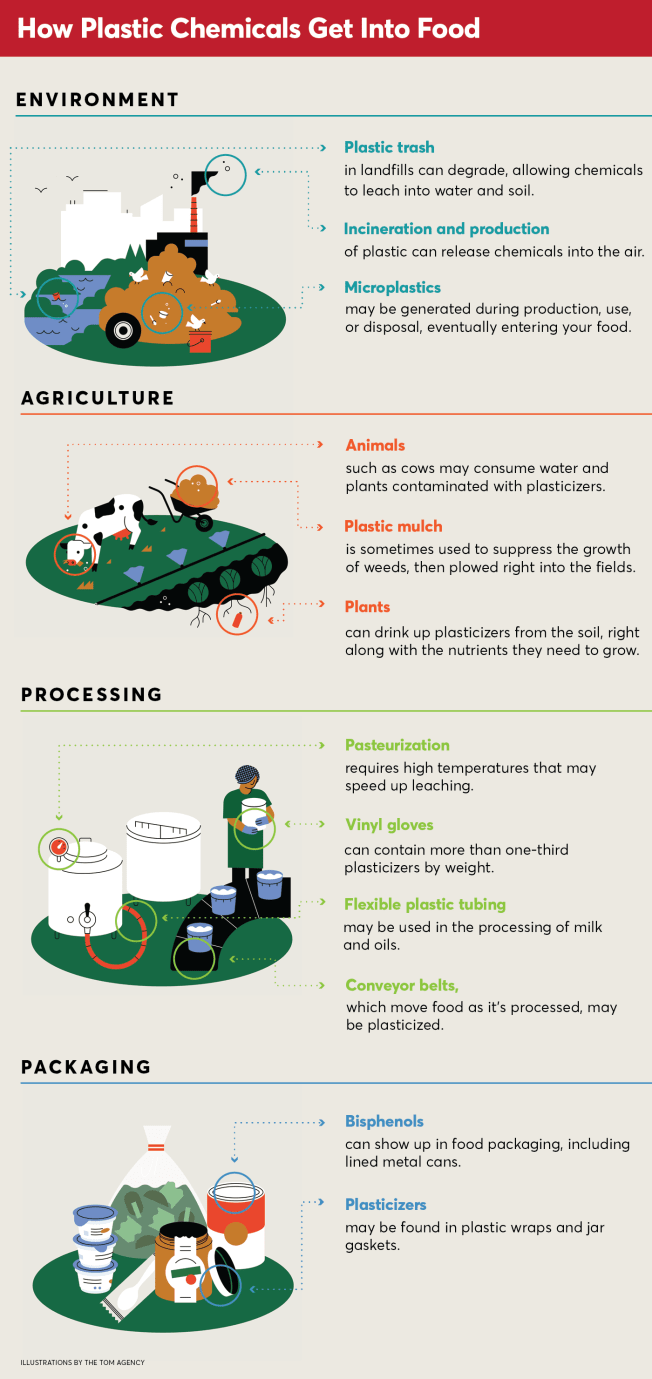
Plastic Chemicals in Foods: What Our Tests Found
The 67 grocery store foods and 18 fast foods CR tested are listed in order of total phthalates per serving. While there is no level that scientists have confirmed as safe, lower levels are better. Our results show that although the chemicals are widespread in our food, levels can vary dramatically even among similar products, so in some cases you may be able to use our chart to choose products with lower levels.
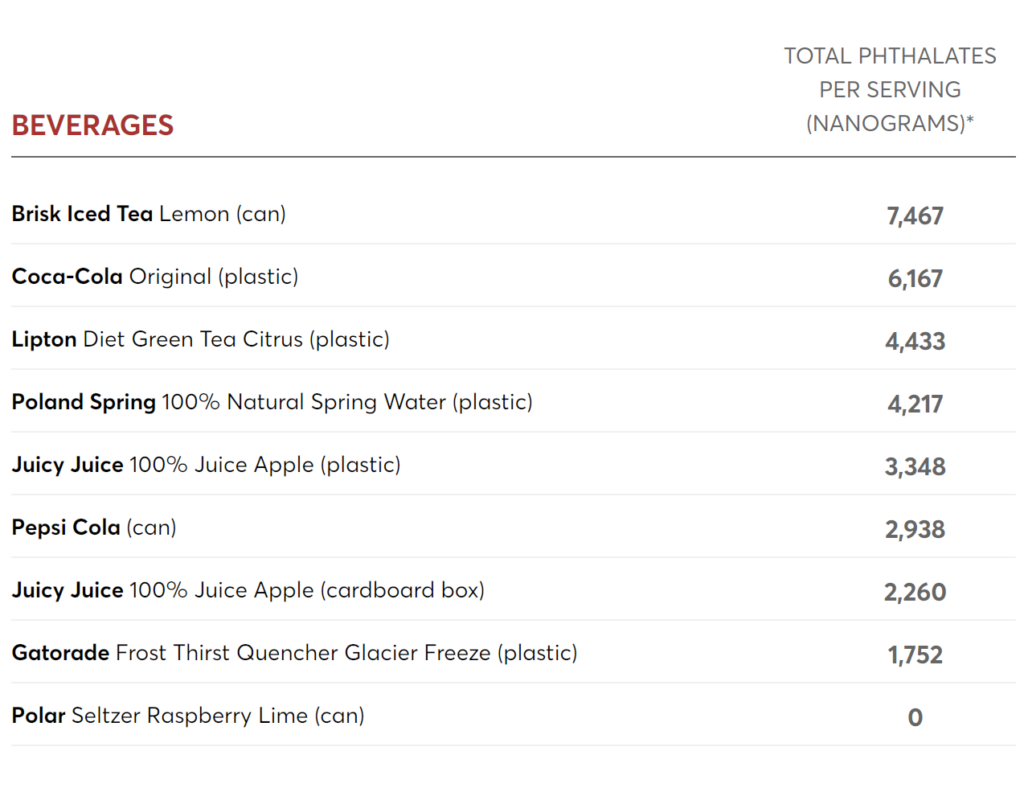

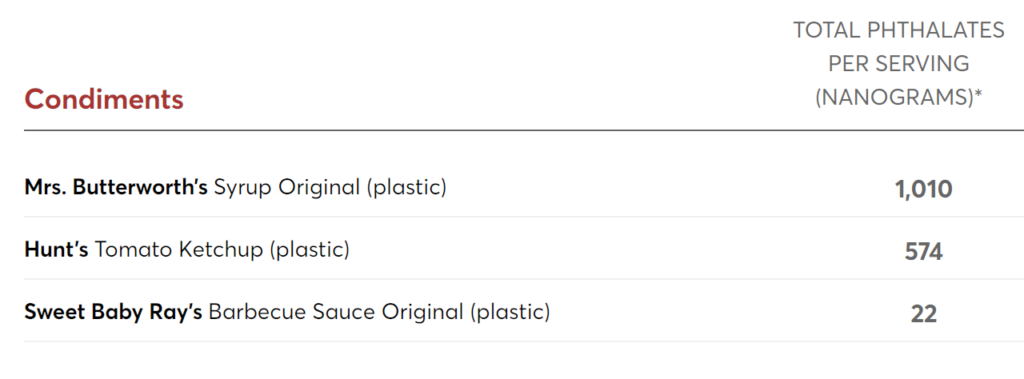
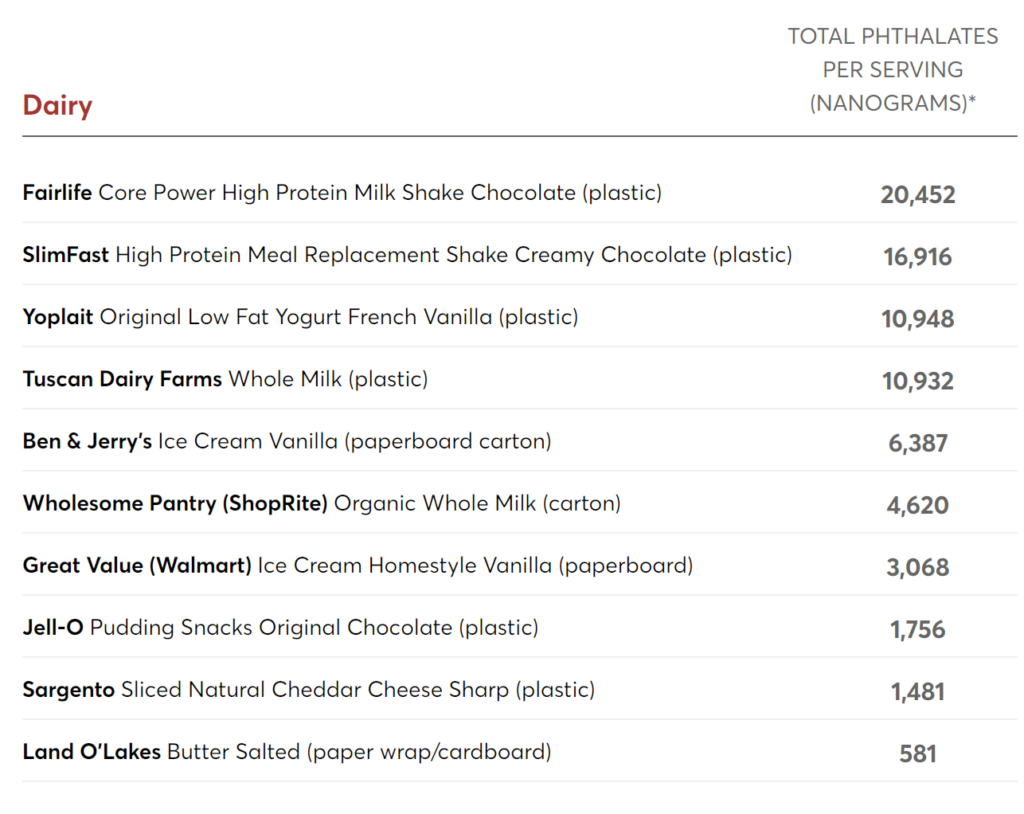
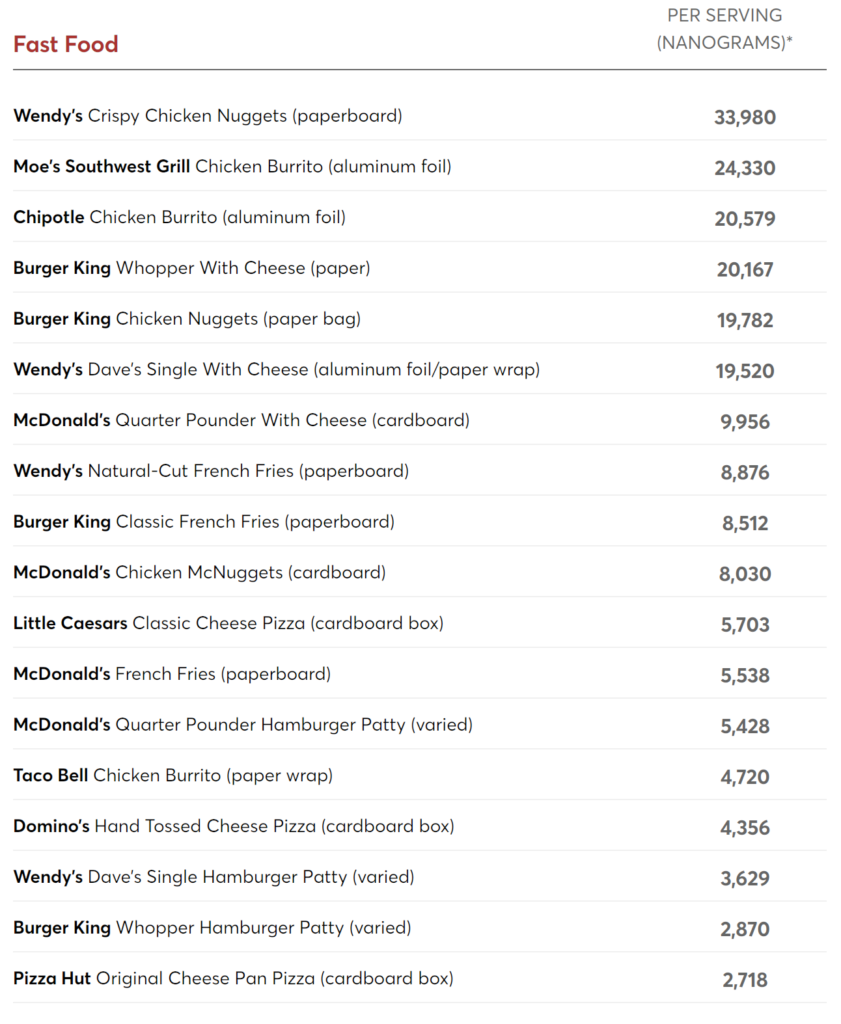
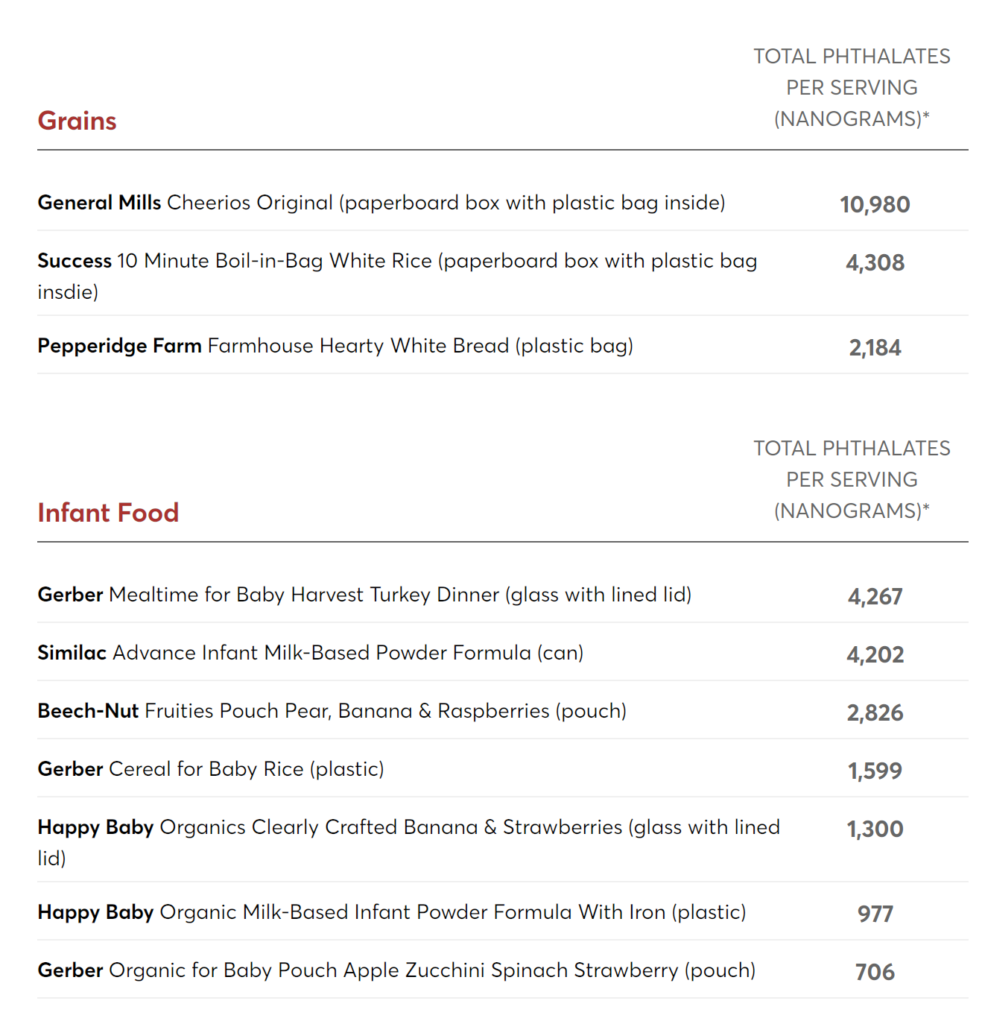
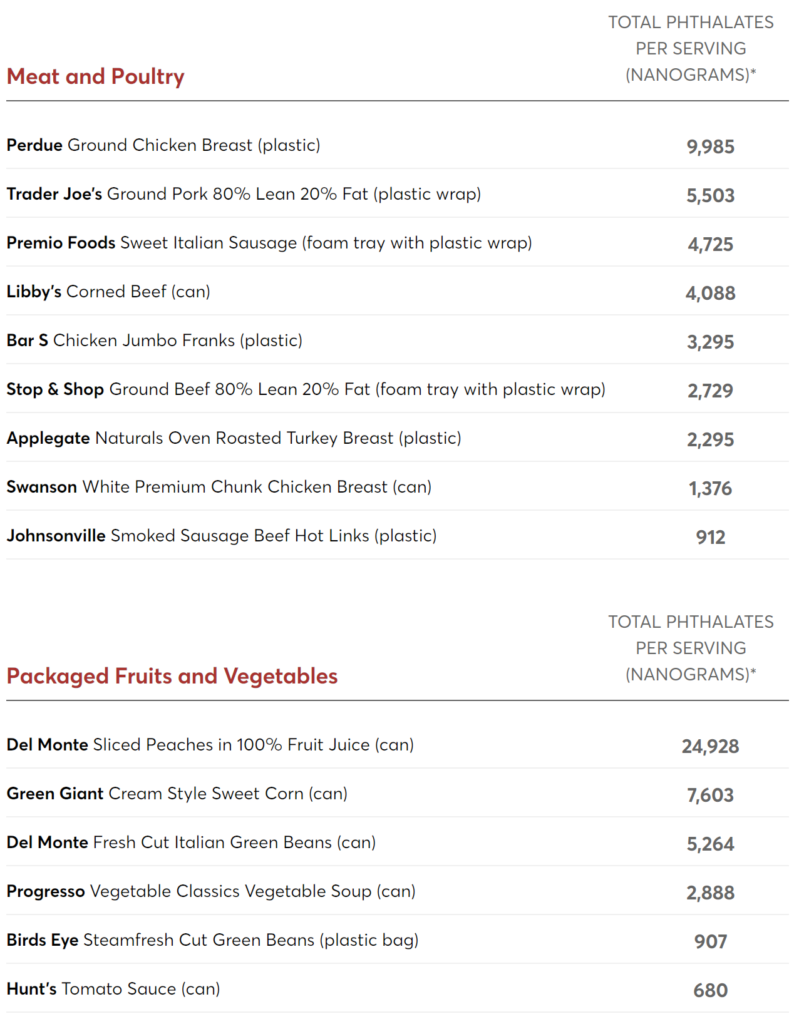
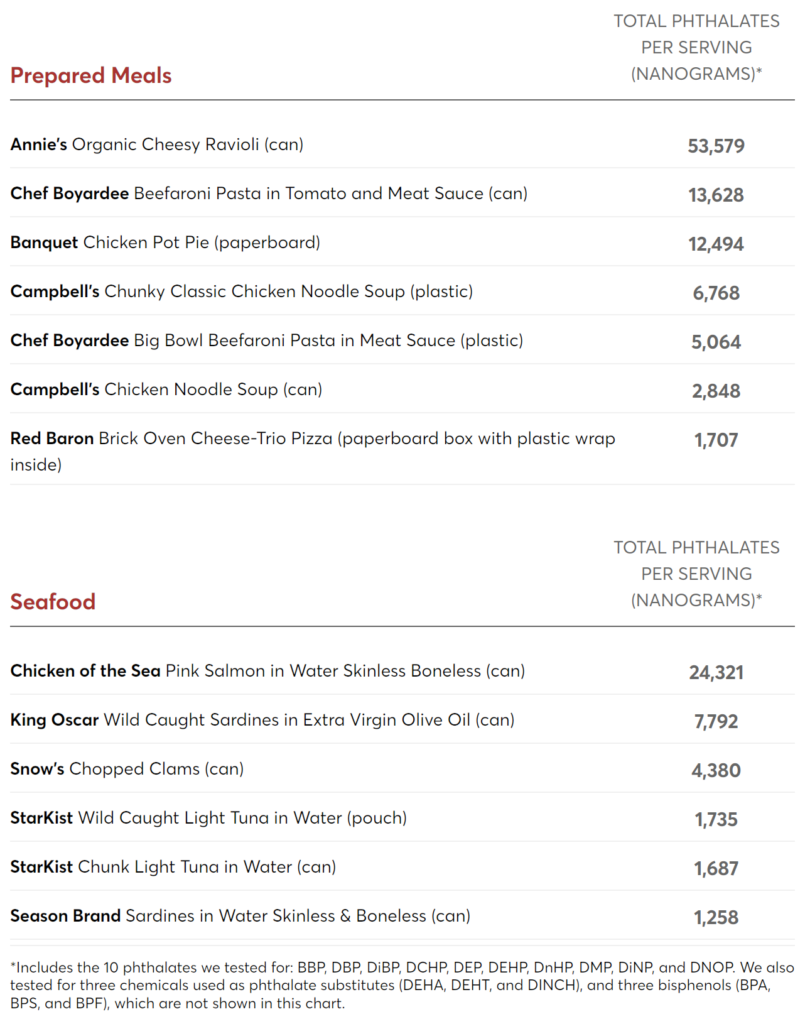
Making Food Safer
Growing concerns about the health risks posed by these chemicals have led U.S. regulators to meaningfully curtail the use of these chemicals in a number of products—but not yet food.
For example, the federal government has banned eight phthalates in children’s toys. But, with the exception of a 2012 ban on BPA in baby bottles (extended in 2013 to infant formula cans), there are no substantive limits on plastic-related chemicals in food packaging or production. Although the Food and Drug Administration no longer allows certain phthalates in materials that come into contact with food, the agency updated its regulations only after those chemicals were no longer in use. And just last year, it rejected an appeal from several groups calling for a ban on multiple phthalates used in materials that come into contact with food.
An FDA spokesperson told CR that in 2022 it asked the food industry and others to provide the agency with additional data about the use of plasticizers in any material that comes into contact with food during production, and might use that information to update its safety assessments of the chemicals.
CR’s food safety scientists and others say such a reassessment by the FDA and other agencies is overdue and essential. “Since bisphenols and phthalates are hazardous chemicals, they should not be allowed at all in food-contact materials,” says Erika Schreder, the science director at Toxic-Free Future, an advocacy group.
Supermarket and fast-food chains, as well as food manufacturers, should also be required to take action, Rogers says, and should set specific goals for reducing and eliminating bisphenols and phthalates from all food packaging and processing equipment throughout their supply chains.
CR contacted certain companies in our tests that had products with the highest phthalate levels per serving, and asked them to comment on our results. Annie’s, Burger King, Fairlife, Little Caesars, Moe’s Southwest Grill, Wendy’s, and Yoplait did not respond to our requests for comment.
Del Monte, Gerber, and McDonald’s emphasized that they abide by existing regulations. Gerber added that it requires its suppliers to certify that its food packaging is free of BPA and phthalates. Chicken of the Sea said it requires its suppliers to certify that neither products nor packaging has intentionally added BPA or phthalates, but it acknowledged that fish live in water that is often polluted with phthalates.
More chemical companies need to step up, too, by creating safer, more sustainable materials. “We want things to be functional, but also nontoxic and biodegradable and renewable,” says Hanno Erythropel, PhD, at the Center for Green Chemistry and Green Engineering at Yale University in New Haven, Conn.
That may be tough, he acknowledges, but it should be possible: An entire field called green chemistry is working to develop just these sorts of alternatives.
In the meantime, see our advice on what you can do now to limit your exposure to these chemicals.
Read the full article here


















